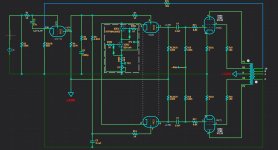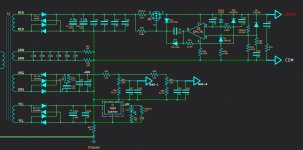I've gotten knee deep in this arc vt60 rebuild. Not sure why, I just kinda fell in love with this amplifier, so I've spent the last couple of months going over the design, asking lots of questions, and just generally trying to make it bulletproof. Changed all the tube sockets because arc's 90s sockets suck, checked and measured and replaced every part that measured off (or that I kissed with the soldering iron by accident) and upgraded the ccs using Pete Millet's ccs boards, which worked out great.
I've got it up and running now, with some vtl branded 6550we, I'm pretty sure they're Sovtek. They're not very well matched, which I know, thanks to my cheeky addition of an extra cathode resistor. Individual bias trims are next on the list, but it's gonna run like this for a while.
My one remaining question, the grid leak resistors. Over the last couple of days, I've been trying to absorb as much information as I can, reading forum threads and posts and technical writings, and I have a good idea about what it's for, so the electrons that collect on the grid have a place to go, and eventually, if the value is too high, it could contribute to a thermal runaway condition. It's also responsible for the input resistance of the output tube, affecting the driver stage's ability to drive the tube without farting.
Here's the problem though, although Rg is on the spec sheets (seemed to be missing from the 6550we Sovtek sheet) quite a few manufacturers don't seem to care much about that specification, and from what I can gather, reports of tubes running away due to too high of a grid leak value seem rare enough that I can't find much.
This amplifier uses 162k, which was actually upped from the 100k the amps shipped with a couple of years later as part of a sonic improvement kit that also added a dn2535 ccs. Apparently, this is way too high for a 6550 or kt120 ->, especially when the resistance of the bias pot and resistor to ground are figured in. If I wanted to stick strictly to the max values on the datasheet, I should really only run kt88s, their maximum Rg being 220k, but this amp shipped like this, and the internet is full of (mostly instrument amps) discussion about changing the Rg values, and very few seem concerned about thermal runaway being a factor.
Opinions seem to range from "it's fine" to "the tubes won't last as long" "will last a while and then start running away if it gets a little gassy" or "will be fine if you keep the bias cool"
What's the actual deal with this? I want this amp to be the best version of itself, and my ocd is not going to allow me to relax and listen to it if all I can envision in my head is a bunch of unhappy electrons stuck on the grids.
I've got it up and running now, with some vtl branded 6550we, I'm pretty sure they're Sovtek. They're not very well matched, which I know, thanks to my cheeky addition of an extra cathode resistor. Individual bias trims are next on the list, but it's gonna run like this for a while.
My one remaining question, the grid leak resistors. Over the last couple of days, I've been trying to absorb as much information as I can, reading forum threads and posts and technical writings, and I have a good idea about what it's for, so the electrons that collect on the grid have a place to go, and eventually, if the value is too high, it could contribute to a thermal runaway condition. It's also responsible for the input resistance of the output tube, affecting the driver stage's ability to drive the tube without farting.
Here's the problem though, although Rg is on the spec sheets (seemed to be missing from the 6550we Sovtek sheet) quite a few manufacturers don't seem to care much about that specification, and from what I can gather, reports of tubes running away due to too high of a grid leak value seem rare enough that I can't find much.
This amplifier uses 162k, which was actually upped from the 100k the amps shipped with a couple of years later as part of a sonic improvement kit that also added a dn2535 ccs. Apparently, this is way too high for a 6550 or kt120 ->, especially when the resistance of the bias pot and resistor to ground are figured in. If I wanted to stick strictly to the max values on the datasheet, I should really only run kt88s, their maximum Rg being 220k, but this amp shipped like this, and the internet is full of (mostly instrument amps) discussion about changing the Rg values, and very few seem concerned about thermal runaway being a factor.
Opinions seem to range from "it's fine" to "the tubes won't last as long" "will last a while and then start running away if it gets a little gassy" or "will be fine if you keep the bias cool"
What's the actual deal with this? I want this amp to be the best version of itself, and my ocd is not going to allow me to relax and listen to it if all I can envision in my head is a bunch of unhappy electrons stuck on the grids.
Attachments
The maximum limitis given on the datasheet are presumably worst case, since the tube manufacturer doesn't want angry phone calls from users who burned out their tubes.
The grid leak resistance must be small enough not to cause a large drift in bias when grid current is present. In general, grid current scales with cathode current and heat in the bottle. So if the tubes are biased conservatively (on the cool side) they can get away with a larger grid leak resistance than the datasheet 'worst case' number. But if they are biased at the brink of destruction then we must listen to the voice of the tube manufacturer. The resistance you can get away with is therefore situational.
The grid leak resistance must be small enough not to cause a large drift in bias when grid current is present. In general, grid current scales with cathode current and heat in the bottle. So if the tubes are biased conservatively (on the cool side) they can get away with a larger grid leak resistance than the datasheet 'worst case' number. But if they are biased at the brink of destruction then we must listen to the voice of the tube manufacturer. The resistance you can get away with is therefore situational.
Last edited:
I do like running tube bias cool, I have the 6550we running ~50mA, I think it ends up being around 35w or so, and probably not too much more if I try a bigger tube. I rather enjoy a bit more tube distortion than I should.
If that buys me enough margin, I won't stress about it too much.
Edit: less than 35w I guess, math seems to suggest more like 20 lol
If that buys me enough margin, I won't stress about it too much.
Edit: less than 35w I guess, math seems to suggest more like 20 lol
Really ? ... ?Here's the problem though, although Rg is on the spec sheets (seemed to be missing from the 6550we Sovtek sheet) quite a few manufacturers don't seem to care much about that specification,,,,
show us one spec sheet from a power tube which does not mention Rg max as a limiting factor, I don't know any ...
The Sovtec 6550WE ds clearly has 51 kohm for fixed bias and 240 kohm for cathode bias (attached).
That's part of the answer: it also depends on whether fixed or automatic bias.
Attachments
I didn't notice it earlier because of how it's listed, but I was assuming it to be the same as other 6550s.Really ? ... ?
Changing the value of Rg, you may affect the voltage gain of the phase splitter stage. Generally, I would just use the same tube that the amp is designed for. (assuming it was designed properly)
assuming it was designed properly
A dangerous assumption, considering. If they were all designed properly, I would expect that none of them would violate the Rg specification, yet, here we are.
I haven't checked my VTL amps yet because there's no schematic and I have to open them to look, and they weigh more than my hemorrhoid can tolerate. My Cary sla-30 right now is the only one that seems to not violate it, using 220k while 300k looks like the maximum, which is a little ironic, considering how many other problems the design has.
- Home
- Amplifiers
- Tubes / Valves
- Grid Leak / Rg - Help me learn!


